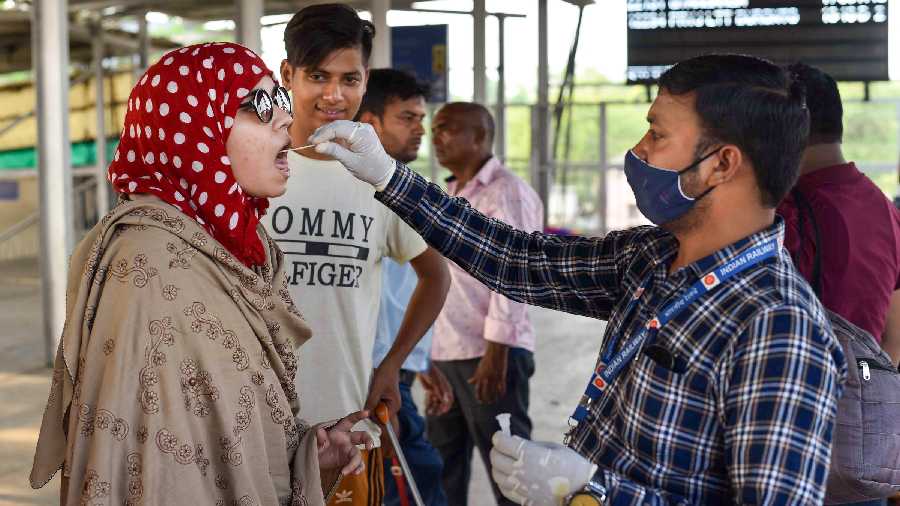A table on “estimated deaths” is missing from India’s annual birth-and-death report for 2020.
The absence has fuelled fresh questions about how the Union health ministry calculated that authorities had registered 99.9 per cent of the country’s deaths in 2020, the Covid-19 outbreak’s first year.
A 99.9 per cent registration level would mean the country had recorded almost all the deaths that had occurred, missing at the most roughly 8,100 deaths.
But a World Health Organisation (WHO) exercise to measure global excess deaths from all causes during 2020 and 2021 has indicated that India accounted for 4.7 million of the 14.9 million excess deaths worldwide.
The Narendra Modi government disputes the WHO estimate. On the Covid-19 toll, the official cumulative Indian figure for 2020 and 2021 is 481,000 (less than half a million). The latest official Covid-19 toll figure (till Sunday) is around 524,000 (5.24 lakh).

It is against this backdrop that, health experts say, the missing table assumes significance.
The table, titled “Estimated events and level of registration”, has been published in every annual report of the Civil Registration System (CRS) over the past decade and features sets of three numbers for India and all the states. The table is absent from the CRS 2020 report.
The three numbers — the mid-year population, the death rate measured through a nationwide sample survey and the estimated deaths — are critical to calculate what proportion of deaths in a state or the country as a whole were registered under the CRS.
The counts of registered deaths, compared against estimated deaths, yield death registration levels. In 2019, for instance, against an estimated 8.3 million deaths, authorities had registered 7.64 million, or 92 per cent.
“The table’s absence from the 2020 CRS report is puzzling,” said a public health expert from a central research institution, who asked not to be named. “It would have shown how they obtained the figure of 99.9 per cent.”
The CRS, the agency that documents births and deaths, had recorded 8,115,882 deaths in 2020. The 99.9 per cent registration level means almost all the deaths, barring roughly 8,100, have been accounted for.
The health ministry, while disputing the findings of studies suggesting that India had undercounted excess deaths during the pandemic, has asserted that the CRS figures should be considered “authentic data”.
The health ministry had in a May 5 statement said, objecting to the WHO’s methodology and estimate, that the country’s death registration level had increased from 92 per cent in 2019 to 99.9 per cent in 2020.
A senior health ministry official told The Telegraph that the 99.9 per cent death registration level was “calculated based on projected addition to the population during the period and death rate as per the Sample Registration Survey (SRS)”.
The SRS is a nationwide survey that usually covers some eight million people to obtain birth rates and death rates, apart from other parameters. The SRS results from 2020 and 2021 are not in the public domain yet.
Queries sent by this newspaper to the health ministry and the office of the Registrar-General of India — the organisation that documents births and deaths through the CRS — asking why the CRS 2020 report does not feature the table of estimated deaths have evoked no response.
But the pandemic itself would have affected the SRS and its results.
“We had a three-month lockdown and other restrictions that could have disturbed the process of conducting the SRS, and both Covid-19 and the associated disruption of health services could have influenced the death rate,” the public health expert said.
Some experts had last week questioned the claim of 99.9 per cent death registration in 2020, flagging a death registration level of 71 per cent measured by the National Family Health Survey (NFHS) 2019-21, itself a health ministry exercise.
“The 99.9 per cent reporting seems implausible and unbelievable,” Bhramar Mukherjee, professor of biostatistics at the University of Michigan in the US who has been tracking India’s Covid-19 epidemic, told this newspaper. “At the same time, the NFHS suggests 71 per cent – what should we believe?”
T. Sundararaman, a public health expert and former executive director of the National Health Systems Resource Centre, a health ministry institution, said that without the SRS data, there was no reliable measure for estimated deaths and, therefore, for the level of death registration.
Sundararaman and other experts say the CRS 2020 report itself appears in some ways to corroborate aspects of the WHO estimate of excess deaths in India during 2020. The WHO had estimated 832,000 excess deaths in 2020 and a cumulative 4.74 million in 2020 and 2021.
The CRS recorded 8.1 million deaths in 2020. “If you compare that to the average of (registered) deaths during the two previous years, the difference is roughly 810,000, close to the WHO estimate,” said Prabhat Jha, professor of epidemiology at the University of Toronto, Canada.
“You shouldn’t compare it to only one year as that is cherry-picking,” Jha said.
Actually, the CRS 2020 report, read along with the 2019 report, Sundararaman said, throws up some hard-to-explain outcomes.
The CRS 2020 report documented 425,000 deaths in Bihar and 873,000 deaths in Uttar Pradesh. If these counts are applied to their populations -– 120 million in Bihar and 225 million in Uttar Pradesh in 2019 -– the death rate in 2020 would be 3.5 per 1,000 in Bihar and 3.8 per 1,000 in Uttar Pradesh.
But in 2019, Bihar had a death rate of 6.6 and Uttar Pradesh had a death rate of 5.6. “If the 99.9 per cent claim is correct and applicable to all the states, the CRS 2020 figures suggest that the death rates in Bihar and Uttar Pradesh miraculously fell by close to 40 per cent in the pandemic’s first year,” Sundararaman said.
“Can we explain that?” he asked.











